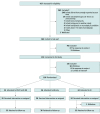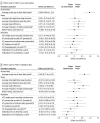Toddler Screen Use Before Bed and Its Effect on Sleep and Attention: A Randomized Clinical Trial
- PMID: 39432278
- PMCID: PMC11581737
- DOI: 10.1001/jamapediatrics.2024.3997
Toddler Screen Use Before Bed and Its Effect on Sleep and Attention: A Randomized Clinical Trial
Abstract
Importance: Toddler screen time has been associated with poorer sleep and differences in attention. Understanding the causal impact of screen time on early development is of the highest importance.
Objective: To test (1) the feasibility of the 7-week parent-administered screen time intervention (PASTI) in toddlers (aged 16-30 months) who have screen time in the hour before bed and (2) the impact of PASTI on toddlers' sleep and attention.
Design, setting, and participants: This assessor-blinded, UK-based randomized clinical trial was conducted between July 2022 and July 2023. This was a single-site study that enrolled families with a toddler aged between 16 and 30 months, living within 75 miles of the Babylab, and with 10 minutes or more of screen time in the hour before bed on 3 or more days a week. Exclusion criteria were (1) a genetic or neurological condition, (2) premature birth (<37 weeks), and (3) current participation in another study.
Interventions: Families were randomized (1:1:1) to (1) PASTI: caregivers removed toddler screen time in the hour before bed and used activities from a bedtime box instead (eg, reading, puzzles); (2) bedtime box (BB only): used matched before-bed activities, with no mention of screen time; or (3) no intervention (NI): continued as usual.
Main outcomes and measures: Feasibility outcomes: participation rate, intervention adherence, retention, family experiences, and assessment acceptability. Efficacy outcomes: screen use, actigraphy-measured sleep, and eye-tracking attention measures.
Results: A total of 427 families were screened, 164 were eligible (38.4%), and 105 families were randomized (mean [SD] age, 23.7 [4.6] months; 60 male [57%]). The trial was feasible, with 99% participant (104 of 105) retention and 94% of families (33 of 35) adhering to PASTI. PASTI showed reductions in parent-reported screen time (vs NI: Cohen d = -0.96; 95% CI, -1.32 to -0.60; vs BB only: Cohen d = -0.65; 95% CI, -1.03 to -0.27). PASTI showed small to medium improvements in objectively measured sleep efficiency (vs NI: Cohen d = 0.27; 95% CI, -0.11 to 0.66; vs BB only: Cohen d = 0.56; 95% CI, 0.17-0.96), night awakenings (vs NI: Cohen d = -0.28; 95% CI, -0.67 to 0.12; vs BB only: Cohen d = -0.31; 95% CI, -0.71 to 0.10), and reduced daytime sleep (vs NI: Cohen d = -0.30; 95% CI, -0.74 to 0.13) but no difference compared with BB only. There was no observable effect of PASTI on objective measures of attention. Compared with BB only, PASTI showed a difference on parent-reported effortful control (Cohen d = -0.40; 95% CI, -0.75 to -0.05) and inhibitory control (Cohen d = -0.48; 95% CI, -0.77 to -0.19), due to an increase in BB-only scores.
Conclusions and relevance: Results of this randomized clinical trial show that, supporting pediatric recommendations, removing screen time before toddler bedtime was feasible and showed modest preliminary beneficial effects on sleep. A future full confirmatory trial is needed before PASTI's adoption by parents and pediatricians.
Trial registration: ISRCTN.org Identifier: ISRCTN58249751.
Conflict of interest statement
Figures


Comment in
-
Future Directions for Screen Time Interventions for Sleep.JAMA Pediatr. 2024 Dec 1;178(12):1245-1247. doi: 10.1001/jamapediatrics.2024.4009. JAMA Pediatr. 2024. PMID: 39432287 No abstract available.
References
-
- Ofcom . Children and parents: media use and attitudes. Accessed December 15, 2023. https://www.ofcom.org.uk/__data/assets/pdf_file/0027/255852/childrens-me...
-
- Common Sense Survey . The Common Sense Census: media use by kids age zero to eight. Accessed December 15, 2023. https://www.commonsensemedia.org/research/the-common-sense-census-media-...
Publication types
MeSH terms
Associated data
LinkOut - more resources
Full Text Sources

